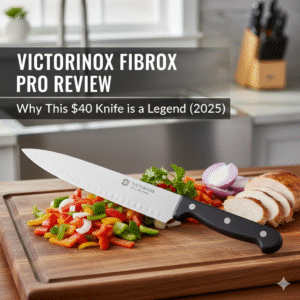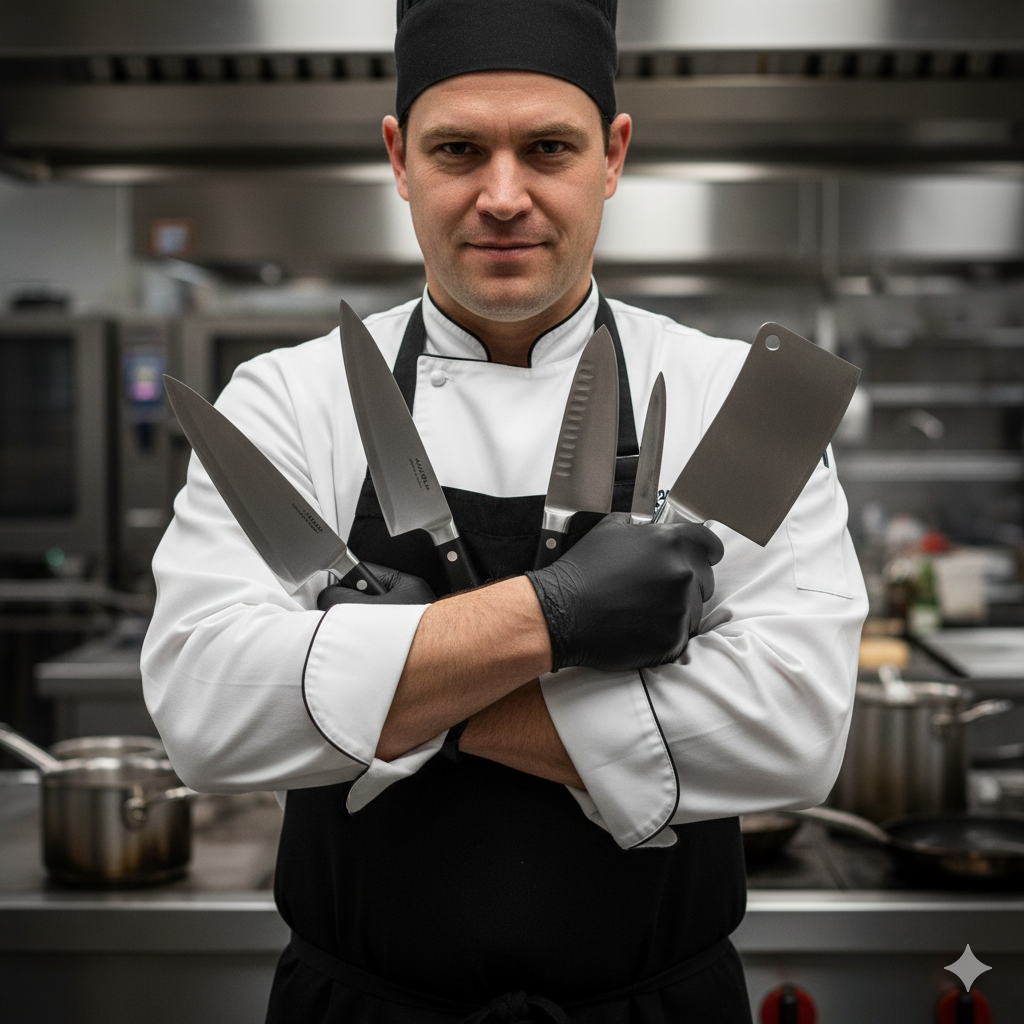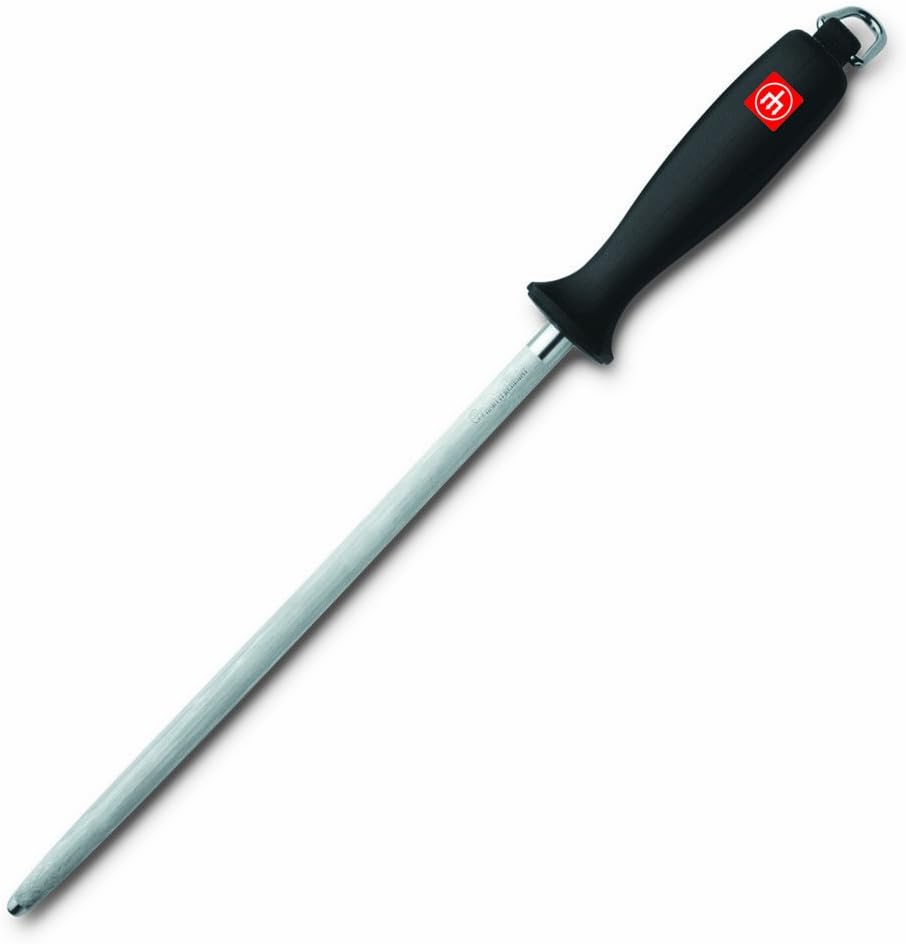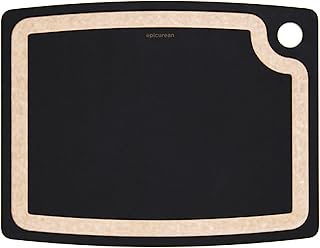Victorinox Fibrox Pro Review: Why This $40 Knife is a Legend (2025)
I need to tell you a secret. It’s a secret that professional chefs, line cooks, and butchers have known for decades. In a world of gorgeous $200 German knives and artistic Japanese blades, one of the best-performing, most reliable chef’s knives you can buy costs less than two movie tickets. It’s the Victorinox Fibrox Pro. It’s not beautiful. It won’t win any design awards. But it is, without a doubt, the single greatest value in the entire culinary world. I’ve owned this knife for 15 years. It was my first “real” chef’s knife, and despite having a block filled with expensive German and Japanese steel, I still find myself reaching for it constantly. This is the story of why this humble Swiss knife is a giant-slayer.
Affiliate Disclosure & Transparency: This review is a labor of love based on over a decade of personal experience. To support my work, this post contains affiliate links. If you buy through them, I may earn a commission at no extra cost to you. My loyalty is to you, the reader, and my goal is to give you the most honest, unfiltered advice possible.
The Verdict in a Nutshell
The Victorinox Fibrox Pro 8-inch Chef’s Knife is the best value chef’s knife on the planet. Period. It offers 90% of the cutting performance of knives that cost 4-5 times as much. Its combination of a razor-sharp edge, incredible durability, and an ultra-practical, non-slip handle makes it the default recommendation for beginners, culinary students, and pros on a budget. It is a tool of pure function, and it is brilliant.
| Sharpness (Out of Box): | ★★★★★ |
| Ergonomics & Grip: | ★★★★★ |
| Durability & Toughness: | ★★★★☆ |
| Ease of Maintenance: | ★★★★★ |
| Aesthetics & Design: | ★★☆☆☆ |
| Overall Value: | ★★★★★ |
The Deep Dive: An Unflinching Look at the Fibrox Pro 8-Inch
Let’s break down this legendary knife piece by piece, from its unassuming blade to its deceptively brilliant handle.

Victorinox Fibrox Pro 8-Inch Chef’s Knife
This is the flagship, the icon, the knife that started it all. It’s the perfect size for 99% of kitchen tasks. Whether you’re a seasoned pro or have never held a proper chef’s knife before, this is the place to start. Its lightweight nature makes it approachable, while its wickedly sharp edge delivers professional-grade results from the very first cut.
Pros
- Incredible sharpness out of the box
- Exceptional value for money
- Fibrox handle offers a secure, non-slip grip
- Lightweight and easy to handle
- Extremely easy to sharpen and maintain
Cons
- Stamped blade lacks the balance of forged knives
- Plain, utilitarian appearance
- Handle may feel cheap to some
The Blade: Deceptively Simple, Shockingly Effective
At first glance, the Fibrox Pro’s blade looks ordinary. There’s no fancy Damascus pattern or mirror polish. But its genius lies in its simplicity.
Stamped Construction & European Steel
The blade is stamped, not forged. This means it’s cut from a large sheet of cold-rolled steel, then shaped, ground, and heat-treated. This is a much more efficient manufacturing process than forging, which is a primary reason for its low cost. The steel itself is a proprietary high-carbon stainless formula from Switzerland. It’s hardened to about 56 HRC, which is the sweet spot for a workhorse knife.
This hardness means the steel is tough enough to resist chipping, but soft enough to be honed back to a razor edge in seconds with a honing steel. It strikes a perfect balance between edge retention and ease of maintenance.
Geometry & The “No Bolster” Advantage
The blade has a relatively flat spine and a gentle curve, making it surprisingly versatile for both rocking and slicing. Crucially, because it’s stamped, it has no bolster (the thick part of metal between the blade and handle). While a bolster adds weight and balance to forged knives, its absence here is a huge advantage: you can sharpen the entire length of the blade, right to the heel. Over years of sharpening, the blade will wear evenly without developing a gap near the handle.
The Handle: The Unsung Hero of Grip and Comfort
If the blade is the business end, the handle is the reason professionals can use this knife for 10 hours straight. The “Fibrox” handle is made from a patented Thermoplastic Elastomer (TPE).
In plain English, it’s a slightly soft, textured, rubber-like material. The feeling is not one of luxury, but of absolute, unshakable security. I’ve used this knife with wet hands, greasy hands while breaking down a chicken, and slimy hands after fileting fish. My grip has never once slipped. The handle is ergonomically shaped to reduce wrist tension, and its lightweight nature makes the entire knife feel nimble and tireless. It is also NSF (National Sanitation Foundation) Certified, meaning it has a sealed handle-to-blade interface that prevents bacteria from building up, a requirement in many commercial kitchens.
Beyond the Icon: Exploring the Victorinox Kitchen Knife Family
While the 8-inch chef’s knife is the star, Victorinox brings its philosophy of function-first value to a whole range of essential kitchen tools. If you love the Fibrox Pro, building out your collection with these is a no-brainer.
The 4-Inch Paring Knife
Arguably as essential as the chef’s knife, this little powerhouse is perfect for all in-hand tasks: peeling apples, hulling strawberries, or deveining shrimp. It’s incredibly sharp and so affordable that you won’t cry if a guest accidentally uses it to open a can. A must-have.
Check Paring KnifeThe 10.25-Inch Serrated Bread Knife
This is another legend in the culinary world. The long, serrated blade with its wavy edge cuts through crusty artisan bread without tearing the soft interior. It’s also a secret weapon for slicing delicate tomatoes or leveling cakes. The offset handle provides knuckle clearance. It consistently outperforms bread knives costing three times as much.
Check Bread KnifeThe Ultimate Showdown: Victorinox vs. The World
Okay, the Victorinox is great for the price. But how does it *actually* stack up against the expensive legacy brands? This is where things get interesting. I’ve spent years comparing these knives, and here’s the honest truth.
Victorinox vs. Wüsthof
This is the ultimate battle of value vs. heritage. The Wüsthof Classic feels like a Mercedes-Benz: solid, powerful, perfectly balanced, and an heirloom piece. The Victorinox feels like a Honda Civic: lightweight, nimble, incredibly reliable, and gets the job done with shocking efficiency. The Wüsthof’s forged blade and bolster give it a satisfying heft that the Victorinox lacks, but the Victorinox’s blade is just as sharp, if not sharper, out of the box. For a full breakdown, you have to read our Wüsthof vs. Victorinox comparison.
Victorinox vs. Zwilling
The story is much the same when comparing it to the other German giant. The premium, German-made Zwilling Pro is a marvel of ergonomics and engineering. But when you look purely at cutting performance, the humble Victorinox is right on its heels. A Zwilling is an investment in feel, balance, and long-term edge retention. A Victorinox is an investment in pure, unadulterated cutting power for the lowest possible price. It’s a fascinating contrast we explore in Victorinox vs. Zwilling.
Victorinox vs. Henckels
This is the true battle of the budget kings. Henckels, the value brand from Zwilling, makes some of the best affordable knife sets. The key difference? Henckels often focuses on providing a more traditional “German feel” (even in their stamped knives) with heavier handles. Victorinox focuses 100% on a lightweight, utilitarian design. If you want a knife that feels more substantial, Henckels might be your pick. If you want pure, lightweight performance, Victorinox wins. We hash it out in our Henckels vs. Victorinox article.
Frequently Asked Questions
Is the Victorinox Fibrox Pro a forged knife?
No, it is a stamped knife. The blade is cut from a sheet of steel rather than being hammered from a single piece. This is a key reason for its affordable price and lightweight feel.
Is this knife good for professional chefs?
Yes, absolutely. It is one of the most common knives found in professional kitchens around the world. Its low cost, high performance, durability, and NSF-certified handle make it an ideal tool for the demanding environment of a commercial kitchen.
Why is the Victorinox knife so cheap?
It comes down to three things: 1) Efficient stamped construction is much cheaper than forging. 2) The TPE Fibrox handle is an inexpensive but highly functional material. 3) They sell millions of them, creating economies of scale. You are paying for pure performance, not expensive materials, marketing, or intricate hand-finishing.
How do I sharpen a Victorinox knife?
It’s incredibly easy. Because the steel is tough but not overly hard, it responds very well to simple sharpening methods. A few passes on a honing steel before each use will keep the edge straight. When it dulls, a simple pull-through sharpener will work wonders. For the best possible edge, learning to use a whetstone is ideal, but not strictly necessary for this forgiving blade.
Final Verdict: Who Should (and Shouldn’t) Buy This Knife?
The Victorinox Fibrox Pro is a masterpiece of utility, but it’s not for everyone.
You SHOULD Buy The Victorinox Fibrox Pro If:
- You are a beginner or a culinary student. This is, without question, the best first knife to buy.
- You value performance and function above all else. You want a tool that works, and you don’t care about fancy looks.
- You are on a budget. This is one of the few times in life where the most affordable option is also one of the best. It’s the king of all the best affordable chef knives.
- You need a reliable “beater” knife. Even if you own expensive knives, the Fibrox Pro is perfect for tasks you wouldn’t risk your prized Shun on, like cutting through a tough winter squash.
You SHOULD NOT Buy The Victorinox Fibrox Pro If:
- You want a knife that feels substantial and weighty. If you love the balance of a forged German knife, the Victorinox will feel flimsy to you.
- You appreciate aesthetics and craftsmanship. This is not an heirloom piece. It’s a tool, and it looks like one. A Wüsthof or Shun is a piece of kitchen art; a Victorinox is a hammer.
- You want a knife that holds its edge for a very long time. While easy to sharpen, its softer steel will require more frequent maintenance than the hard steel of Japanese knives.
In the end, the Victorinox Fibrox Pro’s legacy is secure. It has nothing to prove. It’s a testament to the idea that great design is not about how something looks, but about how it works. It’s a tool that democratized high-performance cooking, making it accessible to everyone. And for that, it deserves a place of honor in any kitchen.
























